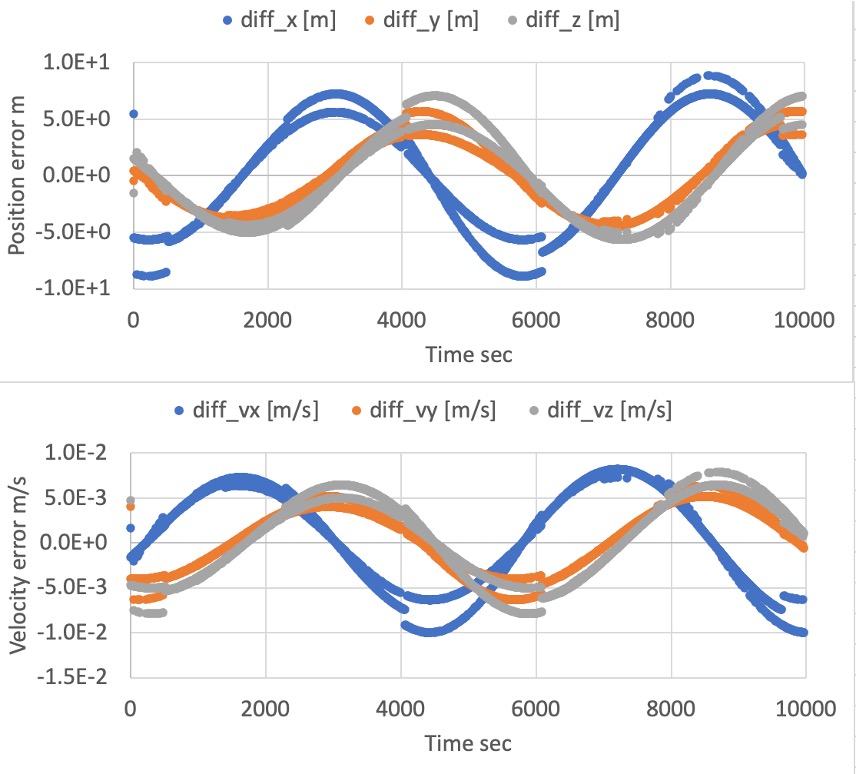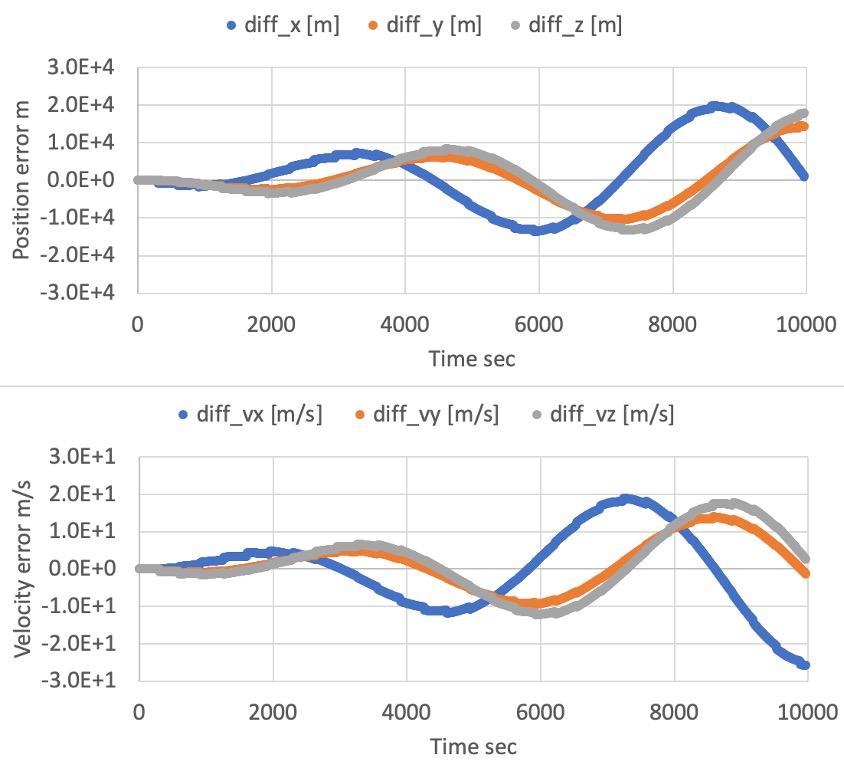Specification for Orbit Propagation with Encke's Method
1. Overview
1. functions
- The
EnckeOrbitPropagationclass calculates the satellite position and velocity with Encke's method, including disturbances and controlled accelerations by the satellite. - This orbit propagation mode provides an accurate and efficient orbit calculation with disturbance forces.
- We can also use it for accurate relative orbit propagation, and the feature will be implemented soon.
2. files
src/dynamics/orbit/orbit.hpp, cpp- Definition of
Orbitbase class
- Definition of
src/dynamics/orbit/initialize_orbit.hpp, .cpp- Make an instance of orbit class.
src/dynamics/orbit/encke_orbit_propagation.cpp, .hpp- We use KeplerOrbit libraries to calculate the reference orbit.
3. How to use
- Select
propagate_mode = ENCKEin the spacecraft's ini file. - Select
initialize_modeas you want.DEFAULT: Use default initialize method (RK4andENCKEuse position and velocity,KEPLERuses init_mode_kepler)POSITION_VELOCITY_I: Initialize with position and velocity in the inertial frameORBITAL_ELEMENTS: Initialize with orbital elements
- Set the value of
error_tolerance, which decides the threshold for the rectification.
2. Explanation of Algorithm
1. EnckeOrbitPropagation::Initialize function
1. Overview
- This function generates the initial value of the reference orbit and the difference orbit.
2. Inputs and outputs
- Input
- $\mu$ : The standard gravitational parameter of the central body
- $t$ : Time in Julian day
- $\boldsymbol{r}_{i}$ : Initial position in the inertial frame
- $\boldsymbol{v}_{i}$ : Initial velocity in the inertial frame
- Output
- The reference orbit
- The difference is set as zero
3. Algorithm
- The reference orbit is initialized as the Kepler Orbit with
OrbitalElements::CalcOeFromPosVelfunction. The detail of the function is described in Specification for Kepler Orbit Propagation
2. EnckeOrbitPropagation::Propagate function
1. Overview
- This function is the main algorithm of Encke's method and calculates the orbit of the spacecraft.
- The method separates the orbit to the reference and the difference. The reference is calculated with the Kepler orbit method as a two-body problem, and the difference is calculated, including the disturbances.
- $\boldsymbol{r}_{ref}$ : Reference orbit
- $\boldsymbol{\delta}$ : Difference
- Please refer to the references to learn the original idea of Encke's method.
2. Inputs and outputs
- Input
- $\boldsymbol{a}_d$ : Acceleration
- $t$ : Current time
- Output
- $\boldsymbol{r}_{i}$ : Initial position in the inertial frame
- $\dot{\boldsymbol{r}}_{i}$ : Initial velocity in the inertial frame
3. Algorithm
- Rectification
- If the norm of the difference is larger than the tolerance, we need to update the reference orbit as the latest orbit information.
- Update reference orbit
- The reference orbit is calculated with the Kepler orbit calculation method.
- Propagate the difference
- Propagate the following differential equation. At this moment, we use the fourth-order Runge-Kutta method as a propagator. \[ \begin{align} \ddot{\boldsymbol{\delta}} &= -\frac{\mu}{r_{ref}^3}(\boldsymbol{\delta}+f(q)\boldsymbol{r})+\boldsymbol{a}_d\\ f(q) &= q \frac{q^2 + 3q + 3}{(1+q)^{1.5} + 1}\\ q &= \frac{\boldsymbol{\delta}\cdot(\boldsymbol{\delta}-2\boldsymbol{r}_i)}{r_i} \end{align} \]
3. Results of verifications
1. Comparison with RK4
1. Overview
- We compared the calculated orbit result between RK4 mode and Kepler mode.
- In the Kepler mode, we verified the correctness of both initialize mode (
ORBITAL_ELEMENTSandPOSITION_VELOCITY_I).
2. Conditions for the verification
- sample_simulation_base.ini
- The following values are modified from the default.
EndTimeSec = 10000 LogOutPutIntervalSec = 5
- The following values are modified from the default.
- SampleDisturbance.ini
- The disturbance setting is depending on the simulation case.
- All disabled or enabled. Other settings are default.
- The disturbance setting is depending on the simulation case.
- SampleSat.ini
- The following values are modified from the default.
propagate_modeis changed for each mode.- Orbital elements for Kepler
semi_major_axis_m = 6794500.0 eccentricity = 0.0015 inclination_rad = 0.9012 raan_rad = 0.1411 arg_perigee_rad = 1.7952 epoch_jday = 2.458940966402607e6 - Initial position and velocity (compatible value with the orbital elements)
initial_position_i_m(0) = 1791860.131 initial_position_i_m(1) = 4240666.743 initial_position_i_m(2) = 4985526.129 initial_velocity_i_m_s(0) = -7349.913889 initial_velocity_i_m_s(1) = 631.6563971 initial_velocity_i_m_s(2) = 2095.780148
- The following values are modified from the default.
- Results
-
The following figure shows the difference between orbit derived with Kepler mode initialized with OE and Encke mode without any disturbances.
- The error is small (less than 10m), and we confirmed that the Encke propagation mode is correct when the disturbances are zero.

-
The following figure shows the difference between orbit derived with RK4 mode and Encke mode with all disturbances.
- The error is larger than the non-disturbance case, but the $10^4 [m]$ error between the Encke method and the Cowell method is compatible with the ref[2] when using the RK4 in LEO. We confirmed that the Encke propagation mode is correct when all disturbances are included.

4. References
- [1] David A. Vallado, "Fundamental of Astrodynamics and Applications, Third Edition", ch.8, 2007.
- [2] Simon P. Shuster, "A Survey and Performance Analysis of Orbit Propagators for LEO, GEO, and Highly Elliptical Orbits", 2017.